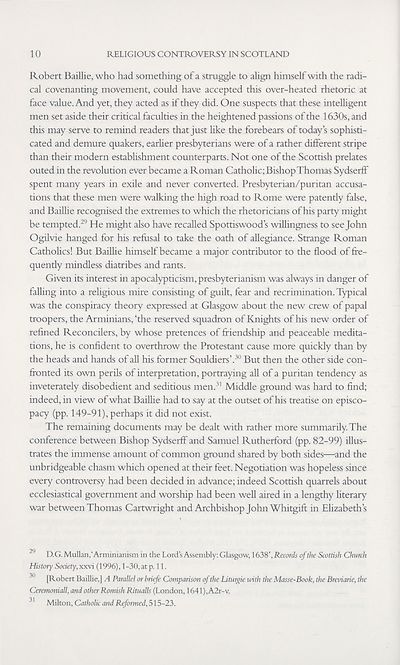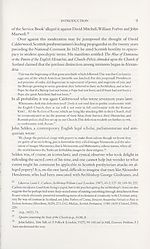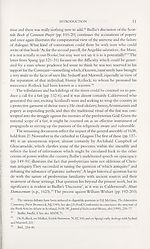Series 5 > Religious Controversy in Scotland 1625-1639
(25) Page 10
Download files
Complete book:
Individual page:
Thumbnail gallery: Grid view | List view

10
RELIGIOUS CONTROVERSY IN SCOTLAND
Robert Baillie, who had something of a struggle to align himself with the radi¬
cal covenanting movement, could have accepted this over-heated rhetoric at
face value. And yet, they acted as if they did. One suspects that these intelligent
men set aside their critical faculties in the heightened passions of the 1630s, and
this may serve to remind readers that just like the forebears of today’s sophisti¬
cated and demure quakers, earlier presbyterians were of a rather different stripe
than their modern establishment counterparts. Not one of the Scottish prelates
outed in the revolution ever became a Roman Catholic; Bishop Thomas Sydserff
spent many years in exile and never converted. Presbyterian/puritan accusa¬
tions that these men were walking the high road to Rome were patently false,
and Baillie recognised the extremes to which the rhetoricians of his party might
be tempted.29 He might also have recalled Spottiswood’s willingness to see John
Ogilvie hanged for his refusal to take the oath of allegiance. Strange Roman
Catholics! But Baillie himself became a major contributor to the flood of fre¬
quently mindless diatribes and rants.
Given its interest in apocalypticism, presbyterianism was always in danger of
falling into a religious mire consisting of guilt, fear and recrimination. Typical
was the conspiracy theory expressed at Glasgow about the new crew of papal
troopers, the Arminians,‘the reserved squadron of Knights of his new order of
refined Reconcilers, by whose pretences of friendship and peaceable medita¬
tions, he is confident to overthrow the Protestant cause more quickly than by
the heads and hands of all his former Squldiers’.30 But then the other side con¬
fronted its own perils of interpretation, portraying all of a puritan tendency as
inveterately disobedient and seditious men.31 Middle ground was hard to find;
indeed, in view of what Baillie had to say at the outset of his treatise on episco¬
pacy (pp. 149-91), perhaps it did not exist.
The remaining documents may be dealt with rather more summarily. The
conference between Bishop Sydserff and Samuel Rutherford (pp. 82-99) illus¬
trates the immense amount of common ground shared by both sides—and the
unbridgeable chasm which opened at their feet. Negotiation was hopeless since
every controversy had been decided in advance; indeed Scottish quarrels about
ecclesiastical government and worship had been well aired in a lengthy literary
war between Thomas Cartwright and Archbishop John Whitgift in Elizabeth’s
29 D.G. Mullan,‘Arminianism in the Lord’s Assembly: Glasgow, 1638’, Records of the Scottish Church
History Society, xxvi (1996), 1-30, at p. 11.
30 [Robert Baillie,] A Parallel or briefe Comparison of the Liturgie with the Masse-Book, the Breviarie, the
Ceremoniall, and other Romish Ritualls (London, 1641),A2r-v.
31 Milton, Catholic and Reformed, 515-23.
RELIGIOUS CONTROVERSY IN SCOTLAND
Robert Baillie, who had something of a struggle to align himself with the radi¬
cal covenanting movement, could have accepted this over-heated rhetoric at
face value. And yet, they acted as if they did. One suspects that these intelligent
men set aside their critical faculties in the heightened passions of the 1630s, and
this may serve to remind readers that just like the forebears of today’s sophisti¬
cated and demure quakers, earlier presbyterians were of a rather different stripe
than their modern establishment counterparts. Not one of the Scottish prelates
outed in the revolution ever became a Roman Catholic; Bishop Thomas Sydserff
spent many years in exile and never converted. Presbyterian/puritan accusa¬
tions that these men were walking the high road to Rome were patently false,
and Baillie recognised the extremes to which the rhetoricians of his party might
be tempted.29 He might also have recalled Spottiswood’s willingness to see John
Ogilvie hanged for his refusal to take the oath of allegiance. Strange Roman
Catholics! But Baillie himself became a major contributor to the flood of fre¬
quently mindless diatribes and rants.
Given its interest in apocalypticism, presbyterianism was always in danger of
falling into a religious mire consisting of guilt, fear and recrimination. Typical
was the conspiracy theory expressed at Glasgow about the new crew of papal
troopers, the Arminians,‘the reserved squadron of Knights of his new order of
refined Reconcilers, by whose pretences of friendship and peaceable medita¬
tions, he is confident to overthrow the Protestant cause more quickly than by
the heads and hands of all his former Squldiers’.30 But then the other side con¬
fronted its own perils of interpretation, portraying all of a puritan tendency as
inveterately disobedient and seditious men.31 Middle ground was hard to find;
indeed, in view of what Baillie had to say at the outset of his treatise on episco¬
pacy (pp. 149-91), perhaps it did not exist.
The remaining documents may be dealt with rather more summarily. The
conference between Bishop Sydserff and Samuel Rutherford (pp. 82-99) illus¬
trates the immense amount of common ground shared by both sides—and the
unbridgeable chasm which opened at their feet. Negotiation was hopeless since
every controversy had been decided in advance; indeed Scottish quarrels about
ecclesiastical government and worship had been well aired in a lengthy literary
war between Thomas Cartwright and Archbishop John Whitgift in Elizabeth’s
29 D.G. Mullan,‘Arminianism in the Lord’s Assembly: Glasgow, 1638’, Records of the Scottish Church
History Society, xxvi (1996), 1-30, at p. 11.
30 [Robert Baillie,] A Parallel or briefe Comparison of the Liturgie with the Masse-Book, the Breviarie, the
Ceremoniall, and other Romish Ritualls (London, 1641),A2r-v.
31 Milton, Catholic and Reformed, 515-23.
Set display mode to:
![]() Universal Viewer |
Universal Viewer | ![]() Mirador |
Large image | Transcription
Mirador |
Large image | Transcription
Images and transcriptions on this page, including medium image downloads, may be used under the Creative Commons Attribution 4.0 International Licence unless otherwise stated. ![]()
| Scottish History Society volumes > Series 5 > Religious Controversy in Scotland 1625-1639 > (25) Page 10 |
|---|
| Permanent URL | https://digital.nls.uk/127328265 |
|---|
| Description | Over 180 volumes, published by the Scottish History Society, containing original sources on Scotland's history and people. With a wide range of subjects, the books collectively cover all periods from the 12th to 20th centuries, and reflect changing trends in Scottish history. Sources are accompanied by scholarly interpretation, references and bibliographies. Volumes are usually published annually, and more digitised volumes will be added as they become available. |
|---|


